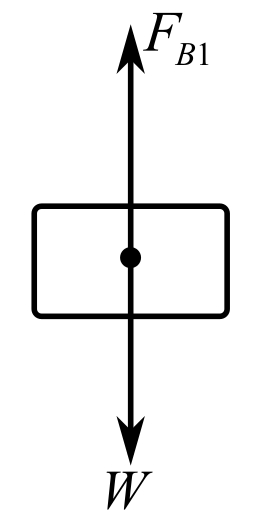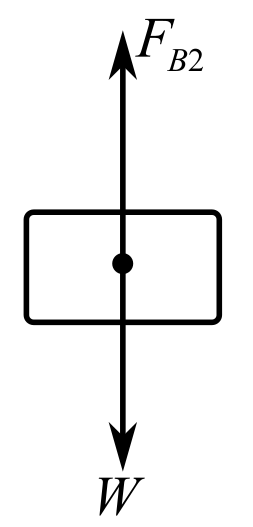
Concept explainers
A 2.0-cm cube of metal is suspended by a fine thread attached to a scale. The cube appears to have a mass of 47.3 g when measured submerged in water. What will its mass appear to be when submerged in glycerin, sp gr = 1.26? [Hint: Find ρ too.]
The mass density of metal and benzene if the metal piece has a measured mass of
Answer to Problem 57SP
Solution:
Explanation of Solution
Given data:
The mass of metal piece in air is
The mass of metal piece in water is
The mass of metal piece in benzene is
Formula used:
The density of a body is calculated using the formula:
Here,
Archimedes’ principle states that the apparent upward force experienced by the solid immersed in a fluid is equal to the weight of the fluid displaced by it. This upward buoyant force on the solid is expressed as
Here,
The weight of a body is expressed as
Here,
The apparent weight of a body submerged in a liquid is calculated as
Here,
Explanation:
Consider the situation when the metal piece is submerged in water and draw its free body diagram:

Here,
Recall the expression for the weight of the metal piece:
Consider, the standard value of acceleration due to gravity as
Substitute
Recall the expression for buoyant force exerted by water on the metal piece:
Here,
Consider the standard value of density of water as
Substitute
Write the expression for the apparent weight of the metal piece in water in terms of apparent mass:
Here,
Substitute
Recall the expression for the apparent weight of the metal piece in water, in terms of buoyant force:
Substitute
Further solve as
It is understood that the metal piece is completely submerged in water, therefore, the expression for calculation of the volume of the metal piece submerged in water becomes:
Substitute
Recall the expression for the density of the metal piece:
Substitute
Thus, the density of the metal piece is
Consider the situation when themetal piece is submerged in benzene and draw its free body diagram:

Here,
Recall the expression for buoyant force exerted by benzene, on the metal piece:
Here,
Substitute
Write the expression for apparent weight of themetal piece in benzene in terms of apparent mass:
Here,
Substitute
Recall the expression for the calculation of the apparent weight of the metal piece in benzenein terms of buoyant force:
Substitute
Further solve as
The density of benzene is
Conclusion:
Thus, thedensity of the metal pieceis
Want to see more full solutions like this?
Chapter 13 Solutions
Schaum's Outline of College Physics, Twelfth Edition (Schaum's Outlines)
- What fraction of ice is submerged when it floats in freshwater, given the density of water 0°C is very close to 1000 kg/m3?arrow_forwardIf your body has a density of 995 kg/m3, what fraction of you will be submerged when floating gently in: (a) Freshwater? (b) Salt water, which has a density of 1027 kg/m3?arrow_forwardThe spirit-in-glass thermometer, invented in Florence, Italy, around 1054, consists of a tube of liquid (the spirit) containing a number of submerged glass spheres with slightly different masses (Fig. P15.70). At sufficiently low temperatures, all the spheres float, but as the temperature rises, the spheres sink one after another. The device is a crude but interesting tool for measuring temperature. Suppose the tube is filled with ethyl alcohol, whose density is 0.789 45 g/cm3 at 20.0C and decreases to 0.780 97 g/cm3 at 30.0C. (a) Assuming that one of the spheres has a radius of 1.000 cm and is in equilibrium hallway up the tube at 20.0C, determine its mass. (b) When the temperature increases to 30.0C, what mass must a second sphere of the same radius have to be in equilibrium at the halfway point? (c) At 30.0C, the first sphere has fallen to the bottom of the tube. What upward force does the bottom of the tube exert on this sphere?arrow_forward
- Mercury is poured into a U-tube as shown in Figure P15.17a. The left arm of the tube has cross-sectional area A1 of 10.0 cm2, and the right arm has a cross-sectional area A2 of 5.00 cm2. One hundred grams of water are then poured into the right arm as shown in Figure P15.17b. (a) Determine the length of the water column in the right arm of the U-tube. (b) Given that the density of mercury is 13.6 g/cm3, what distance h does the mercury rise in the left arm?arrow_forwardThe weight of a rectangular block of low-density material is 15.0 N. With a thin string, the center of the horizontal bottom face of the block is tied to the bottom of a beaker partly filled with water. When 25.0% of the blocks volume is submerged, the tension in the string is 10.0 N. (a) Find the buoyant force on the block. (b) Oil of density 800 kg/m3 is now steadily added to the beaker, forming a layer above the water and surrounding the block. The oil exerts forces on each of the four sidewalls of the block that the oil touches. What are the directions of these forces? (c) What happens to the string tension as the oil is added? Explain how the oil has this effect on the string tension. (d) The string breaks when its tension reaches 60.0 N. At this moment, 25.0% of the blocks volume is still below the water line. What additional fraction of the blocks volume is below the top surface of the oil?arrow_forwardA U-tube open at both ends is partially filled with water (Fig. P15.67a). Oil having a density 750 kg/m3 is then poured into the right arm and forms a column L = 5.00 cm high (Fig. P15.67b). (a) Determine the difference h in the heights of the two liquid surfaces. (b) The right arm is then shielded from any air motion while air is blown across the top of the left arm until the surfaces of the two liquids are at the same height (Fig. P15.67c). Determine the speed of the air being blown across the left arm. Take the density of air as constant at 1.20 kg/m3.arrow_forward
- The gravitational force exerted on a solid object is 5.00 N. When the object is suspended from a spring scale and submerged in water, the scale reads 3.50 N (Fig. P15.24). Find the density of the object. Figure P15.24 Problems 24 and 25.arrow_forwardA 10.0-kg block of metal measuring 12.0 cm by 10.0 cm by 10.0 cm is suspended from a scale and immersed in water as shown in Figure P15.24b. The 12.0-cm dimension is vertical, and the top of the block is 5.00 cm below the surface of the water. (a) What are the magnitudes of the forces acting on the top and on the bottom of the block due to the surrounding water? (b) What is the reading of the spring scale? (c) Show that the buoyant force equals the difference between the forces at the top and bottom of the block.arrow_forwardA Hydrometer is an instrument used to determine liquid density. A simple one is sketched in Figure P9.84. The bulb of a syringe is squeezed and released to lift a sample of the liquid of interest into a tube containing a calibrated rod of known density. (Assume the rod is cylindrical.) The rod. of length L and average density 0, floats partially immersed in the liquid of density . A length h of the rod protrudes above the surface of the liquid. Show that the density of the liquid is given by =0LLh Figure P9.84arrow_forward
- Oil having a density of 930 kg/m3 floats on water. A rectangular block of wood 4.00 cm high and with a density of 960 kg/m3 floats partly in the oil and partly in the water. The oil completely covers the block. How far below the interface between the two liquids is the bottom of the block?arrow_forwardA beaker of mass mb containing oil of mass mo and density o rests on a scale. A block of iron of mass mFe suspended from a spring scale is completely submerged in the oil as shown in Figure P15.63. Determine the equilibrium readings of both scales. Figure P15.63 Problems 63 and 64.arrow_forwardOil having a density of 930 kg/m3 floats on water. A rectangular block of wood 4.00 cm high and with a density of 960 kg/m3 floats partly in the oil and partly in the water. The oil completely covers the block. How far below the interface between the two liquids is the bottom of the block?arrow_forward
 Principles of Physics: A Calculus-Based TextPhysicsISBN:9781133104261Author:Raymond A. Serway, John W. JewettPublisher:Cengage Learning
Principles of Physics: A Calculus-Based TextPhysicsISBN:9781133104261Author:Raymond A. Serway, John W. JewettPublisher:Cengage Learning College PhysicsPhysicsISBN:9781285737027Author:Raymond A. Serway, Chris VuillePublisher:Cengage Learning
College PhysicsPhysicsISBN:9781285737027Author:Raymond A. Serway, Chris VuillePublisher:Cengage Learning Physics for Scientists and EngineersPhysicsISBN:9781337553278Author:Raymond A. Serway, John W. JewettPublisher:Cengage Learning
Physics for Scientists and EngineersPhysicsISBN:9781337553278Author:Raymond A. Serway, John W. JewettPublisher:Cengage Learning Physics for Scientists and Engineers with Modern ...PhysicsISBN:9781337553292Author:Raymond A. Serway, John W. JewettPublisher:Cengage Learning
Physics for Scientists and Engineers with Modern ...PhysicsISBN:9781337553292Author:Raymond A. Serway, John W. JewettPublisher:Cengage Learning University Physics Volume 1PhysicsISBN:9781938168277Author:William Moebs, Samuel J. Ling, Jeff SannyPublisher:OpenStax - Rice University
University Physics Volume 1PhysicsISBN:9781938168277Author:William Moebs, Samuel J. Ling, Jeff SannyPublisher:OpenStax - Rice University College PhysicsPhysicsISBN:9781305952300Author:Raymond A. Serway, Chris VuillePublisher:Cengage Learning
College PhysicsPhysicsISBN:9781305952300Author:Raymond A. Serway, Chris VuillePublisher:Cengage Learning





